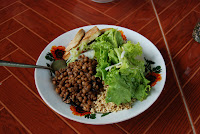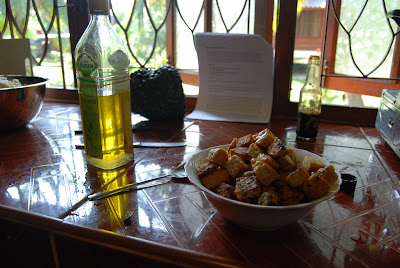Following the latest tragedy in Japan causing immense devastation and nuclear fallout in the region, the importance of eating sea vegetables (or seaweed) has been brought back to public awareness by the international media as a panacea for protecting the body from the harmful effects of radiation. Although algae such as Spirulina and Chlorela have made it to the forefront due to their high nutritional value and proven effects in binding to radioactive substances in the body, there are more, edible and nutritious plants from the earth's waters which have similar and even more powerful effects, and have been used traditionally worldwide for hundreds of years for a wide variety of health issues.
Although strange to most westerners, sea vegetables have played an important role in the cuisine of many traditional cultures around the world. Our common knowledge today is mainly of those cultivated traditionally in Japan and imported to health food stores in the west. Although the Japanese are probably the only culture which has maintained the tradition of eating sea vegetables, it has been used for centuries by natives in the coastal areas of North and South America, Scotland and Ireland, Scandinavia, Russia, the Mediterranean, China, coastal Africa, Australia and the Pacific. They were used in stews, breads, soups and eaten as snacks, all consumed intuitively knowing they provide a large supply of natural minerals and trace elements to the body, and a great deal of flavor to our food. In fact, the artificial flavor enhancer Mono-Sodium Glutamate (MSG), widely used today in the commercial food industry and proven to be detrimental to our health, was originally cultivated and then synthesized from the Kombu seaweed a native of the seas of Japan. Kombu can still be used in it's original form when cooking grains and beans, enhancing their flavor and enriching them with beneficial minerals.
The health benefits of sea vegetables have been well known for centuries. They give a rich taste, color and texture to meals and have traditionally been known to strengthen the kidneys, intestines, digestive system, sexual organs as well as improve concentration and will power. Seaweeds were taken medicinally to dissolve fat and cholesterol deposits due to large intake of animal fat in an earlier stage of life. Sea vegetables have been proved to reverse hardening of the arteries, regulate blood pressure and thyroid activity and even regress tumors as well as binding to radiation and heavy metals and eliminating them from the body.
In addition to food and medicine, seaweeds have been used since ancient times as fertilizer, insulation material, a source of salt and for use in the manufacturing process of glass. Agar agar, a common seaweed in warmer waters and a natural gelatin, is still used today in the food industry as a filler, emulsifier and stabilizer in processed foods and in cosmetics.
Today, although forgotten in most of the western world, the Macrobiotic movement has reawakened the world's interest in these amazing and versatile plants and they are now cultivated again in some of the coastal regions in North America such as New England, Maine, Nova Scotia and California. In many countries such as India and Israel, seaweeds are cultivated on inland farms. Of course, the quality of natural seaweeds from the seas is far greater as it contains the high mineral content of the ocean's salt and energetically, by eating these plants we are connecting the primordial life form which preceded us in the oceans, and still exists in us. The salt composition of sea water is the same of human blood. This enables us to balance our mineral intake and the quality of our blood, building a stronger and healthier body and mind.
Sea vegetables contain high levels of a wide variety of vitamins, minerals and trace elements such as: Iron, Calcium, magnesium, phosphorous, Sodium, Potassium, Zinc, Iodine, Vitamin A, C and many more nutrients which are essential for building healthy bone, nail, hair tissue as well as maintaining and regulating healthy metabolic functions of the body and our hormones. For example, it is known than an Iodine deficiency may cause an imbalance in the thyroid gland. Sea vegetables such as kombu ad Hijiki are recommended for these patients to be eaten daily in their diets.
Mineral Content of Various Sea Vegetables
(milligrams per 100 grams)
Sea Vegetable | Calcium | Phospherus | Iron | Sodium | Potassium |
Agar agar | 567 | 22 | 6.3 | - | - |
Arame | 1170 | 150 | 12 | - | * |
Dulse | 296 | 267 | - | 2085 | 8060 |
Hijiki | 1400 | 56 | 29 | - | * |
Irish moss | 885 | 157 | 8.9 | 2892 | 2844 |
Kelp | 1093 | 240 | - | 3007 | 5273 |
Kombu | 800 | 150 | - | 2500 | * |
Nori | 260 | 510 | 12 | 600 | * |
Wakame | 1300 | 260 | 13 | 2500 | * |
Sources: United States Department of Agriculture and Japan Nutritionist
Association.
Note: A dash signifies a lack of reliable data for a mineral believed to be present
in a measurable amount. An asterisk (*) signifies that information is
not available.
In the next articles we will go further into the details of some of the sea vegetables available to us today, including specific health benefits and recipes. For now we will start with one of my favorites, Arame:
Arame
Traditionally known in the west as sea oak, Arame is a brown algae native of the pacific ocean, mainly on the coasts of Japan and South America. Its wide, thick leaves are dried and shredded into wiry like threads, and then they can be soaked and cooked, turning dark brown and having a sweet, delicate taste. Most commonly they are sauteed with root vegetables or tofu or added to soups and salads.
 Arame is high in complex carbohydrates, fiber, niacin, calcium, iron and iodine, and is used for relief of female disorders and to bring down high blood pressure.
Arame is high in complex carbohydrates, fiber, niacin, calcium, iron and iodine, and is used for relief of female disorders and to bring down high blood pressure.Tempeh & Arame Kinpira
Kinpira is a traditional Japanese dish using root vegetables (carrot, burdock or lotus root together with Arame or Hijiki seaweed. The word Kinpura literally means to saute and simmer, which is exactly what we do in this recipe. It is known to strengthen internal organs and give good Yang energy for weakened vitality. In this Delicious and east to make recipe we add Tempeh as well which gives us good quality protein and the great benefits of a fermented soybeans.
1 package of Tempeh, defrosted
½ cup dried Arame seaweed, soaked in cold water
1 large onion, sliced thinly
2 carrots, sliced into matchsticks
Sesame oil
Salt / Soy sauce
1. Cut tempeh into cubes and fry in oil until golden brown. Remove from pan and dry off the oil.
2. Saute onions and carrots for 2-3 minutes until onions are translucent. Add Tempeh and Arame seaweed and a little water to prevent burning. Add a pinch of salt or a few drops of soy sauce and simmer for 20-25 minutes.















































